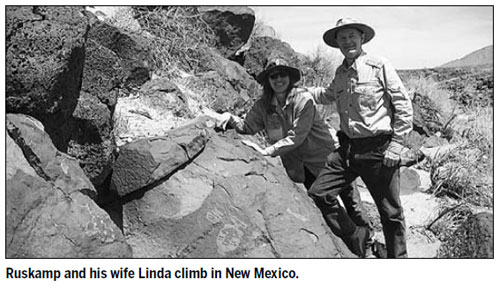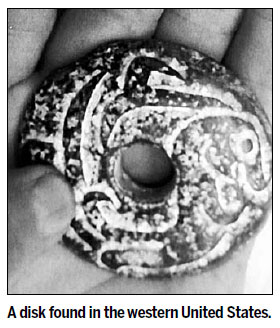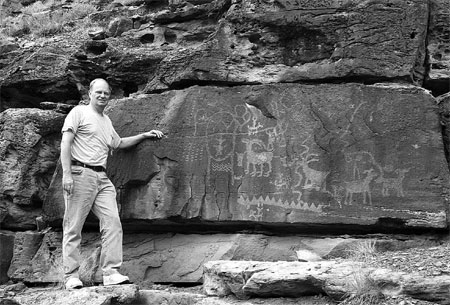History etched in stone
Updated: 2014-01-12 08:37
By Mike Peters(China Daily)
|
|||||||
An enthusiastic amateur believes ancient Chinese script he's found among Native American pictographs prove that Asians crossed the Pacific centuries ago, he tells Mike Peters.
Did migrating Asians settle in the Americas centuries ago?
It's not a new idea, but the theory has a new champion: a mild-mannered retiree named John Ruskamp.
And unlike some of his predecessors - many of whom he cheerfully acknowledges were "crackpots" - Ruskamp believes he's got the long-sought proof.
Writing.
"Multiple groups of North American petroglyphs make the strongest argument," says Ruskamp, who has trekked thousands of miles in the American West to examine and document rock art there.
"They are readable groups of ancient pictograms, Bronze Era Chinese script in most cases. The display of individual and dispersed Chinese pictograms, often integrated into native rock art across North America, demonstrates that these symbols were widely understood as writing."
That's significant for a secondary reason, he says: "Native Americans are not credited as having used writing."
Ruskamp wades into a long-raging controversy bearing four college degrees and a career in each field - biochemistry, education, finance and business. His resume may not impress doubters, and there are many.
"For a long time, there have been wild and unsubstantiated claims for an early Asiatic presence in the Americas. Such non-science unfortunately places a cloud over any new serious research on this topic, so much so that it is often assigned to the 'lunatic fringe' with UFOs and the like," he says.
Ruskamp had been in Asia a few times back in the 1970s.
"I didn't learn the languages, but I grasped the pictorial basis of writing," he says. He followed up that interest with some online courses after he retired years later, and then while hiking in Utah with his family, he was captivated by a drawing on a rock with a heavy patina of age.
"Wait a minute," he recalls thinking, "I've seen that before."
"That", he was convinced, was zhou, the Chinese symbol for a boat.
"The challenge was: Could I find more?" Ruskamp says. "I did - distinctive images of fruit trees and animals, for example - hundreds of them." Such Bronze-era Chinese script definitely dates between 1200 and 200 BC, and "between 900 to 500 BC is the best guess", he says.
While many academic experts have been skeptical, one of the leading Western experts in Chinese script has supported Ruskamp's work.
"You have a Shang ancestor up there, the third Shang king," Ruskamp recalls being told by David N. Keightley, professor emeritus at the University of California at Berkeley and well-known scholar of ancient Chinese script.
"So this is no longer a chance doodle by somebody walking through," Ruskamp recently told experts at Paths Across the Pacific VIII, a conference on cross-continented migration held in Sitka, Alaska. Ruskamp used the event to roll-out the research findings in his just-published second edition of Asiatic Echoes: The Identification of Ancient Chinese Pictograms in Pre-Columbian North American Rock Writing.
"The mostly PhD-level scientific audience overwhelmingly embraced my presentation as conclusive proof for the presence of pre-Columbian Asiatic entry into the Americas, likely around 900-500 BC," he says.
But while Keightley reviewed Ruskamp's book positively and made supportive annotations on the photos, other experts in both the West and China find the dates involved hard to accept.
Ruskamp understands.
"This has not been an easy study to carry out," he says. "Knowledge of both the form of ancient Chinese scripts, Native American folklore and the styles of native rock art are required."
Ruskamp says that if skeptics doubt that Chinese brought their culture to the Americas at least five centuries before Christ, they must believe that the same written language evolved independently, just by chance. The oracle-bone script, carved on turtle shells by the scribes of the Zhou Dynasty (c.11th century-256 BC) was extinct for hundreds of years - only rediscovered in 1899.
"For these things to be phony, they would have to have been created in the past 120 years," he says. His book describes how independent testing of the rock art and its weathering have proved that the carved images are much older.
The narrow historical period of that long-dead writing allows modern scientists to "nail down the date - something that normally in rock art we can't do", he says. "Many examples seem to be classic oracle-bone divination.
"I've published 53 different examples, from the US Southwest to Canada. It's an open script - people across the continent knew what it meant."
But such research, he notes, is a highly speculative endeavor with admittedly a very low probability of success.
"I wouldn't be doing it unless it was enjoyable in its own right," he says with a laugh.
Contact the writer at michaelpeters@chinadaily.com.cn.
|
When hiking in Utah with his family, John Ruskamp was captivated by a drawing on a rock with a heavy patina of age. Photos Provided to China Daily |


(China Daily 01/12/2014 page4)
